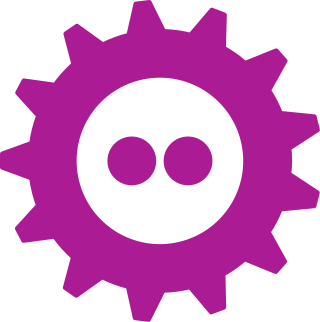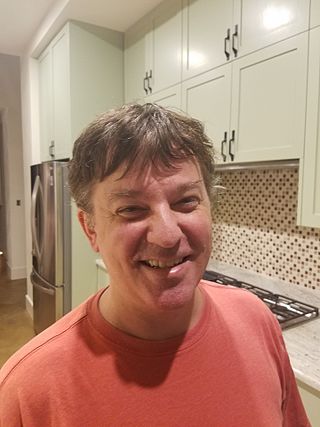A design pattern is the re-usable form of a solution to a design problem. The idea was introduced by the architect Christopher Alexander and has been adapted for various other disciplines, particularly software engineering.

Kent Beck is an American software engineer and the creator of extreme programming, a software development methodology that eschews rigid formal specification for a collaborative and iterative design process. Beck was one of the 17 original signatories of the Agile Manifesto, the founding document for agile software development. Extreme and Agile methods are closely associated with Test-Driven Development (TDD), of which Beck is perhaps the leading proponent.
In computer programming and software design, code refactoring is the process of restructuring existing computer code—changing the factoring—without changing its external behavior. Refactoring is intended to improve the design, structure, and/or implementation of the software, while preserving its functionality. Potential advantages of refactoring may include improved code readability and reduced complexity; these can improve the source code's maintainability and create a simpler, cleaner, or more expressive internal architecture or object model to improve extensibility. Another potential goal for refactoring is improved performance; software engineers face an ongoing challenge to write programs that perform faster or use less memory.
In software engineering, a software design pattern is a general, reusable solution to a commonly occurring problem within a given context in software design. It is not a finished design that can be transformed directly into source or machine code. Rather, it is a description or template for how to solve a problem that can be used in many different situations. Design patterns are formalized best practices that the programmer can use to solve common problems when designing an application or system.
In computing, an abstraction layer or abstraction level is a way of hiding the working details of a subsystem. Examples of software models that use layers of abstraction include the OSI model for network protocols, OpenGL, and other graphics libraries, which allow the separation of concerns to facilitate interoperability and platform independence. Another example is Media Transfer Protocol.
James O. Coplien, also known as Cope, is a writer, lecturer, and researcher in the field of computer science. He held the 2003–4 Vloeberghs Leerstoel at Vrije Universiteit Brussel and has been a visiting professor at University of Manchester.

Free and Open source Software Developers' European Meeting (FOSDEM) is a non-commercial, volunteer-organized European event centered on free and open-source software development. It is aimed at developers and anyone interested in the free and open-source software movement. It aims to enable developers to meet and to promote the awareness and use of free and open-source software.
In computer science, the reentrant mutex is a particular type of mutual exclusion (mutex) device that may be locked multiple times by the same process/thread, without causing a deadlock.
William F. "Bill" Opdyke is an American computer scientist and enterprise architect at JPMorgan Chase, known for his early work on code refactoring.
Domain engineering, is the entire process of reusing domain knowledge in the production of new software systems. It is a key concept in systematic software reuse and product line engineering. A key idea in systematic software reuse is the domain. Most organizations work in only a few domains. They repeatedly build similar systems within a given domain with variations to meet different customer needs. Rather than building each new system variant from scratch, significant savings may be achieved by reusing portions of previous systems in the domain to build new ones.

Google Web Toolkit, or GWT Web Toolkit, is an open-source set of tools that allows web developers to create and maintain JavaScript front-end applications in Java. It is licensed under Apache License 2.0.

Greg Stein, living in Austin, Texas, United States, is a programmer, speaker, sometime standards architect, and open-source software advocate, appearing frequently at conferences and in interviews on the topic of open-source software development and use.
ACCU, previously known as the Association of C and C++ Users, is a non-profit user group of people interested in software development, dedicated to raising the standard of computer programming. The ACCU publishes two journals and organizes an annual conference.

An application programming interface (API) is a way for two or more computer programs to communicate with each other. It is a type of software interface, offering a service to other pieces of software. A document or standard that describes how to build or use such a connection or interface is called an API specification. A computer system that meets this standard is said to implement or expose an API. The term API may refer either to the specification or to the implementation.
Software archaeology or source code archeology is the study of poorly documented or undocumented legacy software implementations, as part of software maintenance. Software archaeology, named by analogy with archaeology, includes the reverse engineering of software modules, and the application of a variety of tools and processes for extracting and understanding program structure and recovering design information. Software archaeology may reveal dysfunctional team processes which have produced poorly designed or even unused software modules, and in some cases deliberately obfuscatory code may be found. The term has been in use for decades.
Douglas C. Schmidt is a computer scientist and author in the fields of object-oriented programming, distributed computing and design patterns.
Linda Rising is an American author, lecturer, independent consultant. Rising is credited as having played a major role in having "moved the pattern approach from design into corporate change." She also contributed to the book 97 Things Every Software Architect Should Know, edited by Kevlin Henney and published by O´Reilly in 2009 (ISBN 059652269X).
Dart is a programming language designed for client development, such as for the web and mobile apps. It is developed by Google and can also be used to build server and desktop applications.
A microservice architecture – a variant of the service-oriented architecture structural style – is an architectural pattern that arranges an application as a collection of loosely coupled, fine-grained services, communicating through lightweight protocols. One of its goals is that teams can develop and deploy their services independently of others. This is achieved by the reduction of several dependencies in the code base, allowing for developers to evolve their services with limited restrictions from users, and for additional complexity to be hidden from users. As a consequence, organizations are able to develop software with fast growth and size, as well as use off-the-shelf services more easily. Communication requirements are reduced. These benefits come at a cost to maintaining the decoupling. Interfaces need to be designed carefully and treated as a public API. One technique that is used is having multiple interfaces on the same service, or multiple versions of the same service, so as to not disrupt existing users of the code.
Angie Jones is a software developer, Java Champion, international keynote speaker, and IBM Master Inventor. She is also the CEO of Diva Chix.




